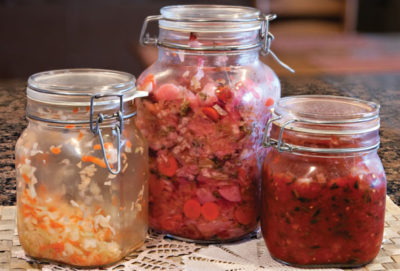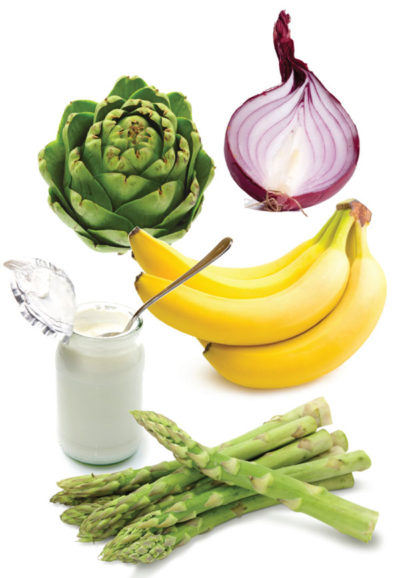Probiotics can also ease an uncomfortable inflammation of the large intestine called ulcerative colitis, which causes cramps and diarrhea. Jeff Isaacson, 43, of Tempe, Arizona, was taking two prescription drugs for ulcerative colitis but still suffering flare-ups. His doctor suggested adding VSL#3, a probiotic cocktail of eight strains of bacteria, to his daily regimen. After two weeks taking the capsules, Isaacson says, “I became basically symptom free.”
As a preventive measure, Dr. Scott Bautch, Wassau, Wisconsin, says he recommends probiotics to replace any good bacteria that are “wiped out” by antibiotics. Taking probiotics can help patients prevent antibiotic-associated yeast infections and even unpleasant episodes of diarrhea.
Probiotics in Dannon’s DanActive and Yakult—a dairy drink from Japan’s Yakult Honsha Co. Ltd.—can also help the immune system. The Federal Trade Commission (FTC) doesn’t allow Dannon to say DanActive prevents colds and flus, so the package reads “helps support your immune system.” But a look at published scientific literature shows there’s at least preliminary evidence that some probiotics, including the ones in DanActive, reduce the duration of upper respiratory infections. And the Cochrane Collaboration, a nonprofit scientific group, concluded in a 2011 review encompassing 14 published studies that probiotics were “better than placebo” in reducing incidence of colds and flus. Further research is needed, particularly in elderly patients, the scientists cautioned.
Probiotics are also a boon to those who can’t digest lactose, a sugar found in dairy products. People who are “lactose intolerant,” can eat yogurt without trouble because it contains bacterial cultures which make lactase, the enzyme needed to digest lactose, says Dennis Savaiano, Ph.D., professor of nutrition science at Purdue University in West Lafayette, Indiana.
“It’s very much like taking a Lactaid pill, but it’s a naturally occurring phenomenon,” says Savaiano. Unfortunately, he adds, the helpful bacteria don’t linger in your gut long enough to provide a long-term cure for your lactose intolerance.
In good news for consumers, the quality of products seems to be improving. In a February report, ConsumerLab.com, which tests nutritional products, found ten out of twelve popular probiotic dietary supplements—83 percent—met its quality standards, including the number of live bacteria promised on the label, up from 15 percent in 2009.

Nonetheless, regulators are taking a hard line on product claims. Over the past two years, the FTC has filed administrative actions against French Danone Group’s U.S. unit, Dannon Co. Inc., and Switzerland’s Nestlé S.A., claiming “deceptive” advertising for their probiotic products. To settle the cases, the companies agreed to soften product claims—for example, neither company is now allowed to claim its products prevent colds and flus.
Consumers looking for probiotic benefits can improve their chances with a few simple rules, scientists and nutritionists say. First, take them daily, since the beneficial effects are short term. Look for products that say “live” on the label, says Gary B. Huffnagle, Ph.D., a professor of internal medicine and microbiology at the University of Michigan in Ann Arbor and author of the book The Probiotics Revolution. That doesn’t necessarily mean refrigerated, as live bacteria can survive in dry foods, such as cereal. There is even a variety that can survive heat, Dr. Huffnagle adds, so it can be baked into muffins and other treats. And watch your dose. The strongest efficacy data that Dannon’s Activia improves transit time of waste through the gut was seen in studies on three four-ounce containers a day, says Miguel Freitas, Dannon’s director of health affairs. Some published research show benefits at lower doses.
Finding the right probiotic for you “is definitely trial and error,” says Huffnagle. In addition to studying probiotics in the lab, Huffnagle has been trying out different probiotics for a decade. He’s found Activia helps his digestion, Yakult seems to keep him healthy in wintertime, and Culturelle, a dietary supplement from i-Health Inc., has eased the mold allergies that used to make him miserable. Before deciding if a product works, he adds, “generally, give it four to six weeks.”
Another approach is to skip commercial products and, like the Bulgarian peasants, get your probiotics naturally.
“Traditionally, people got probiotics from fermented foods,” says Sally Fallon Morell, author of Nourishing Traditions, a popular natural-foods cookbook, and president of the Weston A. Price Foundation, a nutritional education nonprofit based in Washington, D.C. Deli dill pickles, for example, are a good source of natural bacteria—but look for the kind made with salt not vinegar. Mass-manufactured, jarred sauerkraut is heat-treated, so buy it from “your mom and pop deli making it in the back,” says Colorado-based probiotic food consultant Mary Ellen Saunders.
You can also make your own probiotic vegetables using a simple recipe says Fallon Morell, whose advice has helped inspire a national movement which calls itself “demented fermenters.” Simply take any vegetable you like—ground carrots and ginger, for example—and put it in a Mason jar. Add sea salt and whey. Close the jar and leave it on the counter for three days. Then transfer to the refrigerator for two weeks before eating.
“It’s really easy to do and it’s kind of magical,” says Fallon Morell. “You leave it on the counter. Three days later you open the top and the bubbles come up. You feel like an alchemist in the kitchen.”
The Role of Pre-biotics
Supporting the good bacteria already dwelling in your digestive tract.
Our hunter-gatherer ancestors ate a diet high in the plant fiber inulin, says British scientist Glenn Gibson. Today, scientists and nutritionists are recommending inulin as a “prebiotic,” or substance that provides food for beneficial probiotic bacteria, helping it grow and thrive in your gut. “Think of it like fertilizer,” says Gibson, a food microbiologist at the University of Reading.
Inulin is found in chicory, onions, garlic, asparagus, artichokes, bananas, and leeks. But studies have shown about five grams of inulin is needed daily to affect your gut flora significantly. “You’d need a good sackful of onions” to get that much, Gibson says.
Consumers looking for a more efficient method can find inulin in many processed foods. For example, General Mills Inc.’s Yoplait Yoplus yogurt contains both a probiotic and a dose of inulin. You can also get inulin in capsule form. “If probiotics are not doing what you think they should, I recommend adding a prebiotic,” says Dr. Scott Bautch.
Other prebiotics, not found in natural foods but often seen in dietary supplements and packaged foods, include fructooligosaccharide, or FOS for short, and galactooligosaccharide, or GOS.
For a video and more information about probiotics, visit, saturdayeveningpost.com/probiotics
Become a Saturday Evening Post member and enjoy unlimited access. Subscribe now





Comments
I want the State out of my food and body.
There’s no moral justification for government busybodies declaring what I can and cannot eat, coercing me into compliance with violence-backed threats and guns, and charging me via taxation for their unsolicited and unwanted ‘service’.